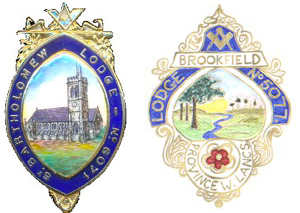The Craft
Freemasonry is called a Craft, partly for historical reasons, partly because, unlike so many fraternities, it requires a training (given in the form of initiation ceremonies) of those seeking its membership.
The Symbolic Degrees of Craft Masonry – The principal idea of Freemasonry as a fraternal organization is to take a good man and make him a better man. A better man internally as well as externally, a better citizen of his community and country, a better husband and father to his children, a better friend and co-worker.
The first involvement for a man becoming a Mason will be the degrees collectively known as Craft Masonry. This system of three degrees is sometimes called The Symbolic Degrees or by the term the Craft. The Craft degrees or ceremonies are called: The Entered Apprentice, Fellow Craft and Master Mason. While there is much speculation as to the origins of Freemasonry it is generally regarded that it is an extension of the operative guilds of stonemasons who worked to build the many cathedrals of Europe. Upon the completion of the gothic cathedrals, the guilds began to accept speculative Masons – that is to say men who were not operative in the Craft.
Certainly Freemasonry having evolved from an operative to a speculative science and philosophy still utilizes the tools of the operative craft to illustrate universal truths and moral concepts. The square, compasses, level and trowel all have symbolic significance and the Master Mason will never look at them henceforth in the same light as he did prior to receiving the degrees.
The degrees of the Craft Lodge center on the building of King Solomon’s Temple as outlined in the Book of Kings as found in the Old Testament, albeit with some poetic license in the person of Hiram Abiff.
In 1813 the United Grand Lodge of England was formed and in 1826 Provinces were created in order to assist UGLE in the management Freemasonry. The Province of West Lancashire is not only the largest of the Provinces ranged under the banner of the United Grand Lodge of England but can also claim to be the birthplace of English Freemasonry.
The initiation of Elias Ashmole as an entered apprentice in Warrington on 16 October 1646 is the earliest recorded initiation into English Freemasonry. All trace of that early Lancashire lodge, if indeed such a lodge existed and was not merely an ad-hoc meeting of conveniently situated Freemasons, has disappeared. The oldest of the existing lodges in the Province is the Lodge of Loyalty No 86 in Prescot which dates from 1753 and still meets on the Wednesday before full moon, although the brethren, of course, can no longer rely on their horses to see them safely home in the moonlight.
The Province was founded as Lancashire Western Division in 1826, becoming the Province of West Lancashire in 1960. It covers that part of the ancient county of Lancashire west of the Great North Road (A6) but including Preston and Lancaster. It extends from the Lake District to the Mersey and from Liverpool into the suburbs of Manchester. Its lodges now meet in five counties – Lancashire, Cumbria, Greater Manchester, Merseyside and Cheshire. West Lancashire province is the largest in UGLE with 342 lodges (as of March 2023).


